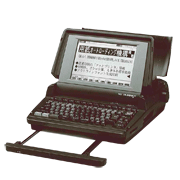NEC began selling the mini5RC personal laptop word processor in February 1991. It was the world’s first word processor with a paper auto-loading mechanism that automatically fed paper from the paper tray located under the keyboard to the printer.
- The mini5RC had the following features.
-
- (1)The mini5RC was standard equipped with a paper auto-loading mechanism that automatically fed paper from the paper tray located under the keyboard to the printer. This made printing easier and less time intensive and also improved the unit’s storage capability.
- (2)The mini5RC made printing more efficient with the standard form print function, which enabled the user to create and print standard forms, such as cover sheets and letterheads, ahead of time and then later print as needed just the portion of the forms that changed.
- (3)High-quality text printing was achieved with the outline font generation function, which could print smooth, attractive scaled characters from both the standard character set and the extended character set. This function also supported the optional Kyokasho and Maru Gothic typefaces.
- (4)The mini5RC’s fast printing was achieved through the combination of a high-speed 16-bit V33 CPU, a 128-dot multi-line printer that could print as many as 2.6 lines per pass, a double buffer that could efficiently position the print head by looking ahead at the subsequent print data, and a super-quick return design that made efficient use of the printer’s three motors.
- (5)The word processor came with Mincho, Gothic, and Mouhitsu typefaces standard, making it easy to create sharp-looking text.
- (6)Operating costs were lowered by supporting inked ribbon cartridges that could be used multiple times.
| Introduced | February 1991 | |
|---|---|---|
| Display device | Monitor |
Backlit, white-mode LCD screen, 640 x 400 pixels 40 Japanese characters x 22 lines (16 x 16 dots, standard display) 80 Japanese characters x 30 lines (8 x 8 dots, condensed display) 20 Japanese characters x 8 lines (32 x 32 dots, expanded display) |
| Entry devices | Keyboard | JIS, 50 kana characters |
| Entry modes | AI conversion, clause-level conversion (200 characters / 40 clauses), kana / alphanumeric, KuTen | |
|
Dictionary Standard AI Other User-defined |
76,000 words 70,000 words 76,000 words 600 words |
|
|
Built-in characters Mincho Gothic Mouhitsu Extended characters |
JIS Level 1 and 2 standard characters 7,375 characters (ROM) 6,864 characters (ROM, floppy disk) 6,864 characters (ROM, floppy disk) 10 characters (170 characters storable on a floppy disk) |
|
| Storage devices | Internal External Other |
30 / 20 pages (1000 characters per page) One 3.5-inch floppy drive (2DD) One memory card slot |
| Printing device | Printer Speed Paper widths Paper feed method |
128-dot multi-line thermal-transfer printer Equivalent to 86 characters/second Prepaid postcard to B4 widths (maximum 90 characters per line) Auto-feed (paper tray built in, accepts A4 and postcard sizes) |
| Typefaces | Standard Optional |
Mincho, Gothic, Mouhitsu 5P (24 x 24 dots), 7P (32 x 32 dots), 10.5 P (48 x 48 dots), 12P (54 x 54 dots) Mincho outline font, Gothic outline font, Maru Gothic, Kyokasho |
| Communications | Communication method | BBS connectivity, bidirectional communications (among mini5 series models), modem board, RS-232C interface optional |
| Other specifications | External dimensions [mm] Weight Power supply Power consumption |
390 x 443 x 126 (w x d x h) 7.9 kg (including the paper tray) 100 ± 10% VAC, 50 / 60 Hz 55 W printing, 20 W standby |


